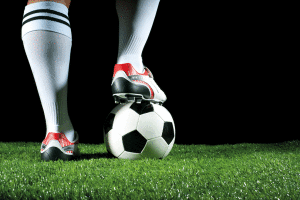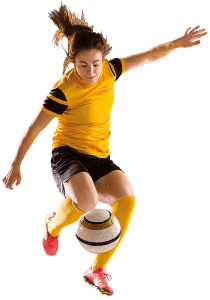FIFA Women’s World Cup - A synthetic debate?

The FIFA Women's World Cup 2015 has been surrounded by controversy concerning the use of synthetic pitches in the tournament. The host nation, Canada, was the only country actually willing to stage the tournament, in stark contrast to the bribery allegations, scandals and subsequent arrests involving the allocation of host countries for recent and up and coming men's World Cups.
Having decided on the venues, FIFA and the Canadian Soccer Association (CSA) announced their controversial decision to use synthetic pitches. This resulted in 84 players representing 13 countries filing a lawsuit against FIFA in Canada's Court of Human Rights, citing risk of injury and gender discrimination. Players from the United States, Brazil, Australia, New Zealand, Japan, Germany, Mexico, Spain, South Korea, Columbia, France and Costa Rica, including stars like Abby Wambach and Nadine Angerer, all got involved.
It has been observed that, if these football players had been men, the lawsuit would most definitely have been featured on every news broadcast and website around the world but, as those affected and involved were sportswomen, the lawsuit received a significant lack of media coverage. Not only this, but the players made it clear from the beginning that they had no intention of boycotting the tournament, meaning that FIFA didn't feel threatened enough to do anything on their behalf.
The governing body delayed the case several times, slowing down the decision on the merits of the case. Hampton Dellinger, the lawyer representing the players, stated that, despite the players proposing compromises and being willing to do a deal, FIFA were having none of it. "They just would not engage." he recalls. "They said repeatedly there is no plan B, this World Cup won't take place on grass."

"FIFA were having none of it. They just would not engage. They said repeatedly there is no plan B, this World Cup won't take place on grass"
Additionally, at least three Football Federations intimidated players into withdrawing from the lawsuit. Teresa Noyale from the Mexican National Team, as well as French internationals Camille Abily and Elise Bussaglia, all withdrew from the lawsuit after threats about being suspended or dropped from their teams. Diana Saenz and Katherine Alvarado of Costa Rica also received threats, but opted to continue with the lawsuit. As a response to the withdrawal of these players, almost the entire German National Team signed on to the lawsuit, showing a solidarity and banding together in a way that professional athletes rarely do.
The lawsuit was dropped in January this year, after it became clear that FIFA had no intention of changing their decision in time for the tournament. With the World Cup fast approaching, the players needed to be certain of what surface they would be playing on. Dellinger stated,
"In a world where you have two responsible parties, agreements can be reached. We certainly hoped that would have been the case here... Certainly we're disappointed, but I think it was an important effort." England's Anita Asante said of the decision to drop the lawsuit:
"Regardless of the outcome of the competition, it's important that the discussions continue, and that it's not just a forgotten thing. As much as it might affect players in the competition now, it's also a question to think about for the future, for generations to come."

"Regardless of the outcome of the competition, it's important that the discussions continue, and that it's not just a forgotten thing. As much as it might affect players in the competition now, it's also a question to think about for the future, for generations to come"
Feminist issues aside, but certainly not forgotten, we are all left wondering what the potential risks to injury are, and whether synthetic pitches really do alter the way the game is played.
FIFA would argue that they don't, and commissioned Prozone statistics and Uefa medical expertise to argue this for them. The governing body also have a Quality Concept for Football Turf, to ensure that there is a "recognised standard for football turf pitches". The quality testing uses real turf as its benchmark and awards FIFA Recommended Marks to those pitches that meet the "very stringent quality criteria", which includes passing tests in the durability of the surface, ball/surface interaction, and the player/surface interaction.
The player/surface interaction is of particular note here, as tests are conducted to examine the features of the pitch that would most strongly influence risk of injury to the player. For a FIFA Recommended 1 star field, shock absorption, vertical deformation, rotational resistance and slip resistance are tested and passed, whilst for a 2 star field, turf is also tested and passed for skin abrasion and skin friction. All criteria are tested using machines designed for the purpose.
This doesn't seem to be enough for synthetic turf sceptics however, which Bryn Lee, Commercial Director of Bonar Yarn, one of the pitch suppliers for this year's tournament in Canada, has a theory about, "Opinions on 3G's inferiority to natural grass are largely emotional rather than logical, since many of the objections raised have been robustly disproved... Players need only look at the facts, rather than believe the hysteria, when they next come to question 3G's credentials."

"Opinions on 3G's inferiority to natural grass are largely emotional rather than logical, since many of the objections raised have been robustly disproved... Players need only look at the facts, rather than believe the hysteria, when they next come to question 3G's credentials."
So, is it just the stigma attached to synthetic pitches that puts athletes off? I am sure all of us remember some AstroTurf related burn injury from our youth, whether that was in the 70s, or early 2000s. The unearthly green colour and rug-on concrete composition of the original stuff, first introduced to pro sports in 1966 at the Astrodome in Houston however, has made way for the more advanced FieldTurf of today. Plastic grass sits atop a spongy base of crumbled reclaimed rubber tyres, providing more cushioning and a slightly less artificial appearance.
But a slightly less artificial appearance is not enough for those athletes who value tradition, and value playing on the natural surface that football was made for. Anita Asante says; "we value having grass - the tradition, how it responds to our bodies. We appreciate the nature of being on actual grass: the smell, the feeling, the sentiment." But, aside from this uneasiness at this movement away from the preferred natural surface, there is also the matter of the potential changes in a player's performance, with many citing that these synthetic pitches can have negative effects.
With high bouncing turf, the precision passing characteristic of the top levels of the sport can be compromised. Germany goalkeeper, Nadine Angerer, spoke about the "dry" pitches in the tournament this year, "It's hard to reach the balls as you never know how they will bounce. Both teams have the same problem, but of course it affects the game." Abby Wambach, USA forward, also had a few things to say about the surface for this World Cup and, although her comments about not being able to score goals because of the synthetic turf were met with ridicule by the media, it seemed that she might have a point. In the USA's draw with Sweden, for example, there was a moment when everybody thought that the USA would score in the 72nd minute. Wambach dived head-first into the goal area and connected well on a cross.

"It's hard to reach the balls as you never know how they will bounce. Both teams have the same problem, but of course it affects the game."
She drove it low towards the turf, but the ball took a high and unnatural bounce towards the hands of the goalkeeper, who didn't even have to reach out to guide the ball over the crossbar. But not only goal-scoring opportunities can be affected. Japan's captain, Aya Miyama, has also commented that "dribbling was difficult" on the new turf. "The natural turf was easier for us. The ball movement could be predicted."
Bonar Yarns has something to say about this though. When asked whether synthetic pitches alter how the game is played, they answered: "No, and certainly not in the way many believe. The ball travels across the surface naturally and tactics need no adaption from natural grass to 3G. Additionally, the greater stability and weather resistance provided by the turf facilitates improved ball control." We must assume that the people at Bonar Yarns know better than the players experiencing the changes in their own performance.
Now to the health implications of playing on a synthetic pitch as opposed to natural turf. Bonar Yarns states: "The biggest concern amongst players is simultaneously the biggest misconception. The yarns used in synthetic surfaces are incredibly soft and industry research, as well as practical application, has shown no link between 3G and increased injury risk."
In an interview with Jan Ekstrand, Professor in Sports Medicine, team doctor of the Swedish national team in the 80s and 90s, and currently vice-chairman of the UEFA Medical Committee, FIFA.com asked about his studies on synthetic turf. The studies were conducted over ten years ago, and tested top teams that played all of their home matches on artificial turf and their away matches on natural grass, in order to compare the incidence of injury on both surfaces. His study concluded that the total risk of injury is the same on FIFA-certified football turf as it is on natural grass. He also states that there was no difference in the incidence of leg burn after tackles made on both surfaces: "In fact, we actually saw more instances of leg burn on natural grass."
"Some studies show a small difference in the injury pattern, with an increase in ankle ligament injuries on synthetic turf, but a decrease in muscle injuries." It seems then, that when scientifically tested, there are no significant injury risk increases in synthetic turf. It must be noted however, that the studies only focused on injuries that caused absence from either training or matches: "There may have been sore muscle or back pain issues that were not part of the studies, but which were reported by some players and teams." Also, there have been no studies on the long-term impact of playing on synthetic pitches or on the differences in the quality of the synthetic turf. But it does seem that, for now, there is no scientific evidence to blame the synthetic pitches for injuries suffered whilst playing football.

So what, I hear you ask, if the footballers get grazed a bit more severely? Maybe it would stop them from their ridiculous dives after near-fatal wafts of air from the opposing team? But what if the pitch reached a scorching temperature of 49OC, as it did before the opening match of this year's Women's World Cup? At more than twice the air temperature, this raised serious concerns for the welfare of the players. It is not only tough on players' feet, but can cause extra fatigue. Studies conducted by Penn State's Centre for Sports Surface Research in Utah found that surface temperatures of synthetic turf were generally 20OC to 30OC hotter than natural grass, with the highest temperature recorded in research of 93OC (200OF)! No wonder then, that there is a chance of discomfort, dehydration and heat stroke.
The same study also looked into the mechanisms that are often used to cool the turf before play, concluding that the popular wetting of the pitch does reduce the temperature, but only for a short period of time, with one study by McNitt et al. in 2008 showing that temperatures rebounded just twenty minutes after watering. At five feet above the surface, the air temperature above the synthetic turf returned to almost that of the natural grass surface, but that doesn't help for anything much, other than the player's head and maybe shoulders.
Aside from the potential fatigue caused to the athlete, concerns have been raised about the material that makes up the shock absorbing infill of the synthetic 3G pitches. 400,000 or so reclaimed rubber tyres are used for each pitch, crumbled up and used to fill the gaps between the plastic grass. An ingenious idea at the time it seemed, as the USA were starting to ban the tyres from being disposed of in landfills, and there was a massive build up of used tyres above ground. Ingenious it may be, but only if you discount the fact that the tyres were banned from landfills because of the nasty chemicals that they contain.
A bit confusing then, that they decided to increase the surface area of these potentially carcinogenic ingredients by crumbling them up and putting them into pitches to be used by anyone - from small children to professional athletes. These days, the synthetic turf industry recycles one twelfth of the 300 million auto tyres that are withdrawn from use each year.
Four chemicals found in the tyre crumbs have been labelled carcinogens by the International Agency for Cancer Research (IARC), including carbon black, which makes up 20-40% of the synthetic infill. To make matters worse, studies have shown that, as temperatures rise, the rubber crumbs emit more volatile chemicals and, as we have seen, the temperatures of these synthetic pitches can reach high levels.
Although the Synthetic Turf Council maintains that these synthetic pitches do not pose any threat to athletes, there have been worrying observations of suspicious groupings of cancer cases in goalies exposed on a regular basis to synthetic pitches.
Last year, Amy Griffin, head soccer coach for the University of Washington, began to question whether it was the chemicals in the rubber crumb in synthetic turf that were making goalies that she had coached, as well as goalies internationally, develop cancer. Goalkeepers, whose bodies are in constant contact with the turf, can get the rubber crumbs from the turf into their cuts and scrapes, as well as in their mouths.

"I've coached for twenty-seven years. My first fifteen years, I never heard anything about this. All of a sudden it seems to be in a stream of kids"
"I've coached for twenty-seven years. My first fifteen years, I never heard anything about this. All of a sudden it seems to be in a stream of kids," Griffin says. She has since compiled a list of thirty-eight American soccer players - thirty-four of whom are goalies - who have been diagnosed with cancer. Blood cancers such as lymphoma and leukemia dominate the list.
Dr Davis Lee of the Synthetic Turf Council responded to these observations; "We've got fourteen studies on our website that say we can find no negative health effects." Although they aren't "absolutely conclusive," he says; "There's certainly a preponderance of evidence, to this point, that says, in fact, it is safe."
But Nancy Alderman, president of the nonprofit public health group Environmental and Human Health, has huge reservations. She says of the predominance of blood cancer; "Whenever you see a preponderance of one kind of cancer, that's when you worry. Goalies are 'in the stuff' all the time, so they are actually more exposed than the other players." When speaking of the matter, Connecticut state toxicologist David Brown said to Alderman, "Oh my god, we really have to look into this - I know what's in tyres." He also says of the studies that have been conducted so far, that there "is no study with sufficient sample sizes to determine the potential hazard."

"Whenever you see a preponderance of one kind of cancer, that's when you worry. Goalies are 'in the stuff' all the time, so they are actually more exposed than the other players."
We must not blame FIFA, or any of the other organisations and governing bodies that have installed synthetic pitches, for the health concerns raised of late, as there is obviously a lot more research to be done on the matter. But why did FIFA and the Canadian Soccer Association decide that synthetics were the way to go for the Women's World Cup this year? It has a lot to do with the weather conditions, apparently, although we at Pitchcare believe that the host nation could quite easily cultivate and maintain six grass pitches over the two month period of the tournament.
In fact Moncton, the venue that saw England and France play their first game of the tournament, already had a grass field, which was taken up and replaced with synthetic turf before the tournament began. The 3G pitch will give way to natural turf again when the tournament ends.
FIFA General Secretary, Jerome Valcke, disagrees with this: "Most sporting infrastructure in Canada is on artificial turf, primarily due to the extreme climate. It would be very difficult to ensure solid natural grass pitches at all venues." FIFA claims that the quality of the game is decidedly better on an artificial pitch than a poorly maintained natural pitch, but then, it would be expected at high level football that the pitches would be well maintained, wouldn't it?

"Most sporting infrastructure in Canada is on artificial turf, primarily due to the extreme climate. It would be very difficult to ensure solid natural grass pitches at all venues."
Surely, the money would have been put into natural turf installation and maintenance for the men's tournament if an issue like this were to arise, as the campaigners of the lawsuit highlighted. It would certainly have been expensive to install grass pitches at the Canadian venues, and as journalist Matthew Syed of The Times points out; "the problem with 'equality' in sport is often, at the bottom, an economic issue rather than a legal one. The Women's World Cup is loss-making. It requires a hefty cross-subsidy from the men's event to take place at all."
So, is it a case of economics? With many of the synthetic pitch installations taking place, in Scotland for example, it seems that it is. The allure of generating extra income from the rental of synthetic pitches for community uses explains why so many teams have gone artificial. Of course in Scotland, the weather conditions are less than perfect and, as Celtic manager Ronny Deila moans; "The pitches in Scotland are terrible. It's much better to play on an artificial surface than to play on a natural turf surface."

"The pitches in Scotland are terrible. It's much better to play on an artificial surface than to play on a natural turf surface."
But it must not be assumed that this is the sole reason for the switch, as many clubs feel that they will add to their revenue with synthetic surface rental fees, whilst also reducing cost in the maintenance of their pitches.
The increase in a club's revenue is definitely something that the synthetic pitch manufacturers promote, and it is interesting to see the breakdown of the revenue that certain contractors, such as McArdle Sport-Tec Ltd, predict.
McArdle predict £87,120 revenue per football season for their FIFA 1 star pitches. That figure is based on 42 hours play per week, 36 weeks of the year. The installation of one of their pitches will set you back £365,500, with a maintenance cost per annum of £109,620 based on a 5-year finance agreement.
Of course, the FIFA 2 star pitches required for international play will cost more, at around the £700,000 mark for installation. But then, for some teams, this is a mere drop in the ocean compared to how much they pay their players. When we talk about community level and grassroots football, on the other hand, the capital needed for the installation, as well as the replacement costs and maintenance costs will add up.
So, now we have looked at the different arguments involved with the installation of synthetic pitches over natural turf, I will leave you all to make up your own minds. I have become slightly biased after doing the research for this article, but I acknowledge that synthetic turf has its uses and its place.
What I would like to see, in the not too distant future, is another, more environmentally-friendly, health-friendly and play-friendly synthetic turf, with a move away from rubber crumb.
American company, Limonta Sports are pioneering a move away from rubber crumb with their coconut fibre and cork infill, GeoTurf, which they claim to be 100% environmentally friendly and, I assume, non-carcinogenic!
So, let's hope we will have a good balance of safe, synthetic turf and natural turf in the coming years, as well as an equality between male and female players in their pitch surface preference.

After completing her schooling in Spain, she headed back to England to study Sports and Exercise Science at the University of Exeter. A keen team player, but perhaps not always as skilled at sport as she would like to be, she was once told she "had the perfect attitude to be on the volleyball team, but not the skill."
